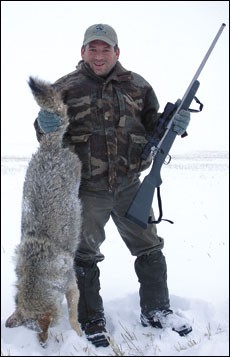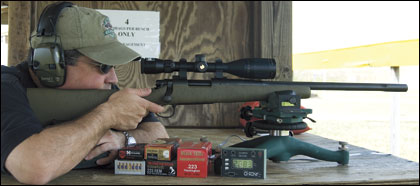September 23, 2010
By Greg Rodriguez
Shots are often at moving animals or call-shy dogs that stop just briefly to examine my decoy or at the sound of my squeak.
By Greg Rodriguez
 Calling call-wise, farm-country coyotes into range is no mean feat; Greg shot this one at over 300 yards. An accurate, easy-handling predator rig helps make those long shots a snap. |
If ever there was a misunderstood firearm, it is the predator rifle. Though the "varmint" designation, at least to me, connotes a heavy-barreled, target-type rifle intended for extended, long-range shooting on prairie dogs, many shooters use the term to describe predator rifles as well. But the long, heavy rigs favored by varmint shooters aren't even close to the rifles preferred by predator hunters.
Varmint hunters generally snipe their quarry from a solid, steady perch, but predator hunters usually carry their guns great distances as they walk from one call site to another, trying to lure a wily songdog, fox, or bobcat into range. I've shot coyotes that practically ran me over, and I've shot them — or at least shot at them — from 400 yards or more. Those shots are often at moving animals or call-shy dogs that stop just briefly to examine my decoy or at the sound of my squeak. Demanding shooting and the running-and-gunning-style savvy predator hunters prefer to make the predator rifle a fairly specialized gun.
Advertisement
I am a big fan of AR-15s, but most bolt-action predator rifles are less expensive than ARs, and many hunters find turn-bolts lighter in weight and easier to use. Consequently, bolt-actions reign supreme in the predator hunting field.
To me, the ideal predator rifle is a relatively trim, compact rifle with a light- or medium-contour barrel of 20 to 22 inches. Those shorter barrels are easy to maneuver in tight brush, and they're fast on target. Either length will get the job done out to 350 yards or more when chambered for predator cartridges such as the .223 Remington or the .22-250 Rem.
Advertisement
Predator rifles should be bedded into a stock with a relatively trim, sporter profile. Such stocks are ideal for rifles that will be carried a lot. In addition to being lighter and easier to carry, sporter-style stocks are much easier to shoot from field positions than heavier, varmint-style stocks.
I am not a big camo devotee, but good camouflage is essential for predator hunting. Predators have incredible vision, and the more you can do to foil it, the better your odds of calling one to within range. At the very least, a predator rifle should have a camo stock, though full camouflage is a much better choice.
Optics for predator hunting should be robust enough to handle bouncing around in a truck and clear enough to discern a brush-colored critter at first and last light. An easy-to-use long-range reticle like Nikon's BDC or Leupold's B&C can be a big help if you hunt in wide-open areas where shots beyond 300 yards are likely. I prefer low-profile, 3-9X scopes with one-inch tubes and objective lenses in the 36 to 40mm range. Such optics are lightweight and compact but more than capable of dealing with 99 percent of predator hunting scenarios.
Several cartridges work well for predator hunting. I've used bigger, more versatile cartridges such as the .243 Win., 6mm Remington, and .25-06 Rem., as well as light-kicking numbers like the .204 Ruger and .22 Hornet. All worked reasonably well; however, the bigger cartridges can be a bit much during extended firing sessions. The smaller rounds, on the other hand, don't always do the job on heavy-bodied coyotes. Their performance is especially suspect at long range and in high winds. The .220 Swift is another fine round, but it requires a longer barrel than any predator rifle should wear.
 Remington's Model 700 XTR Compact Tactical is an excellent predator rig, though the author would switch to a smaller 3-9X scope. |
I still use the .22 Hornet and .204 Ruger a great deal in areas like the Texas Hill Country, where the ranges are short and I only expect to encounter foxes and bobcats. But the last few years, I've come to rely on the .223 Rem. and .22-250 Rem. for the majority of my predator work. Both pack plenty of punch and shoot more than flat enough for my purposes. Each has its strong points.
The .223 excels in availability, variety, and price. I've yet to see a store that carried ammunition that didn't have at least one or two types of .223 ammunition. And stores that carry lots of ammunition usually offer a wide variety of .223 loads. Available .223 offerings range from lightweight, thin-jacketed varmint bullets to heavy match bullets intended for long-range work to solidly constructed bullets — Nosler Partition and Speer Trophy Bonded come to mind — that work just fine on deer and hogs. None of these offerings are expensive compared to bigger cartridges or the more exotic lightweights. My own favorite .223 predator bullet is Nosler's 55-grain Ballistic Tip as loaded by Federal and Winchester.
Among the .22-250's advantages are its flat trajectory and increased energy over the .223. It's a bit more expensive to shoot and harder on barrels if you shoot it a lot, but predator rigs don't usually get shot that much. If you call coyotes out West, its flatter trajectory and energy advantage make the .22-250 the obvious choice. My favorite .22-250 load is Hornady's 60-grain Spirepoint. Though a 55-grain V-Max would probably be even more devastating on varmints, the 60-grain SP will penetrate the neck or shoulder of the hogs I often encounter as I walk from call site to call site in the South Texas brush.
An increase in the number of predator hunters the last few years has led several manufacturers to introduce predator-specific models. The following are three of my favorites.
Remington's 700 XTR Compact Tactical is the green, civilian version of one my favorite Model 700s — the law-enforcement-only Light Tactical Rifle. At 7½ pounds sans scope, it is no lightweight, but it's light enough to make the predator hunting grade when topped with a compact 3-9X scope. Its 20-inch barrel is fluted, and its stainless-steel barreled action is coated for increased corrosion resistance and locked down into an aluminum bedding block that is molded in to a synthetic stock. It is a rugged, accurate rifle that makes a dandy predator rig.
Savage's Predator Hunter weighs just 7.25 pounds thanks to its 22-inch, medium-contour barrel and synthetic stock. The camo-coated rifle comes with Savage's excellent AccuTrigger; an oversized bolt knob; and a detachable, four-round magazine. It is av
ailable in .223 or .22-250 as well as .204 Ruger or .243.
 Weatherby's camouflaged Predator Rifle is based on the company's Vanguard action. It is ideal for running and gunning in coyote country. |
Weatherby's new Vanguard Predator has a 22-inch, number three contour barrel and a synthetic stock. It is coated in Natural Gear camo, which works just as well out West as it does in the South Texas brush. The 8-pound rig has a five-round magazine. Predator-specific offerings include the .223 and .22-250, though it is also available in .308.
Ruger's M77 Hawkeye Predator is the most recent predator-specific rifle to hit the market, but it's so new, I've yet to get my hands on one.
If predator hunting is only an occasional sideline, you can get by quite nicely with any reasonably accurate rifle. But if you're serious about calling coyotes, cats, or foxes, a dedicated predator rig is a must.
With the right blend of accuracy, portability, and stealth, these specialized rigs will help you raise your predator hunting game to the next level. A few more prime pelts will make that new rig worth every penny.
